Open
Platform for Monitoring
the
Quality of IPv6 Interconnection of End
Users in Greece
1. Introduction
The
Hellenic
IPv6
Task Force
established an open platform for monitoring the
quality of IPv6
interconnection of end users in Greece. One of the first objectives of
this activity is to estimate the «IPv6 brokenness», i.e. the percentage
of end users that fail to access digital content over HTTP using
IPv6/IPv4, and the "IPv6 penetration", i.e. the percentage of users
with IPv6 connectivity.
This activity is organised in the context of the companies’ preparation
for the World IPv6 Launch Day
on 6th of June, 2012. |
|
2. Participation
At the time of writing (May '12), the following members participate to this
activity:
Note: All
the Internet Service Providers (ISPs) and Content Providers are invited
to
participate to this activity. For further information, please refer to
[1].
3.
Process
The
collection and process of data is based on existing best practices [2,
3]. The basic steps are as follows:
- A content provider adds a non-visible frame in an IPv4-only web site. The frame contains a link to a script, hosted at
the server operated by GRNET (v6metrics.grnet.gr).
- After accessing the IPv4-only site web, the end users' browser executes the script.
- The
script initially logs the necessary information for the offline
analysis - e.g.
request ID, IP address, etc- and initiates two additional requests for
accessing 1x1-pixel images; one over IPv4-only (A record) and one over
IPv6/IPv4 (AAAA/A records).
- The server (v6metrics.grnet.gr) logs
any
IPv4/IPv6 successful hits to the 1x1-pixel images.
4. Analysis &
Graphs
The
preliminary results are shown in the following graphs. Note that the
initial statistical results may divert from the reality as the
statistical sample collected may not accurately respesent the Internet
conditions (e.g. traffic, connections, hits, failures, etc) in Greece.
- IPv6 Bronenness: It
is estimated using the formula IPv6_Brokenness
(%) = 100 * (Ns - Nd) / Ns, where Ns number of successful IPv4-only
hits
and Nd number of successful
IPv6/IPv4
hits. The
first graph shows the weekly average while the second graph depicts the
raw data per day. Note that IPv6 brokeness 0,10% means that 1.000
subscribers every million of subscribers have none or low quality
IPv6/IPv4 access to
dual stack web sites. Various
reasons for broken IPv6 connections are referenced in [2]. The
descrease in the IPv6 brokenness is related with measures taken
by the ISPs in order to solve connectivity problems (May '12). The
decrease may also be related with the collection of statistics of
Internet Users connected outsite Greece but accessing the web site of
the Greek content provider.
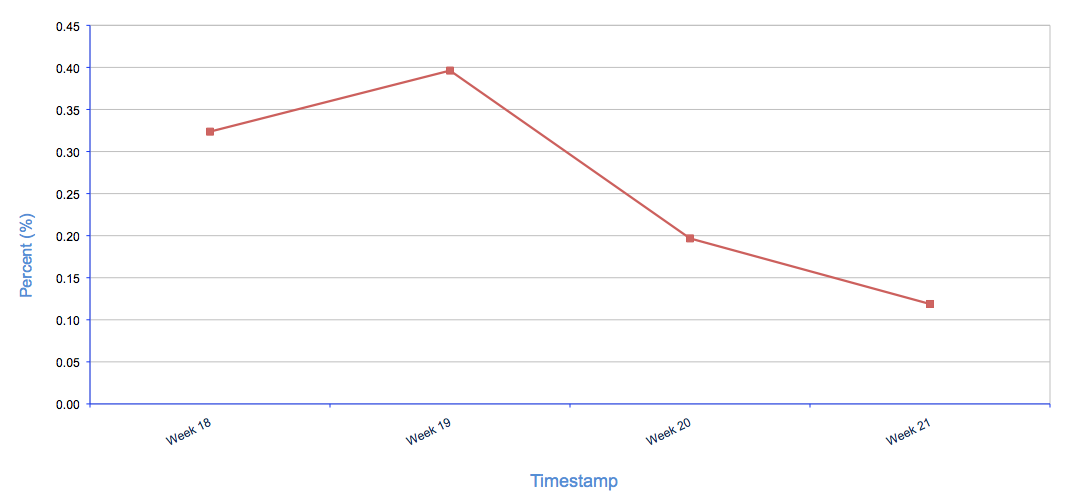
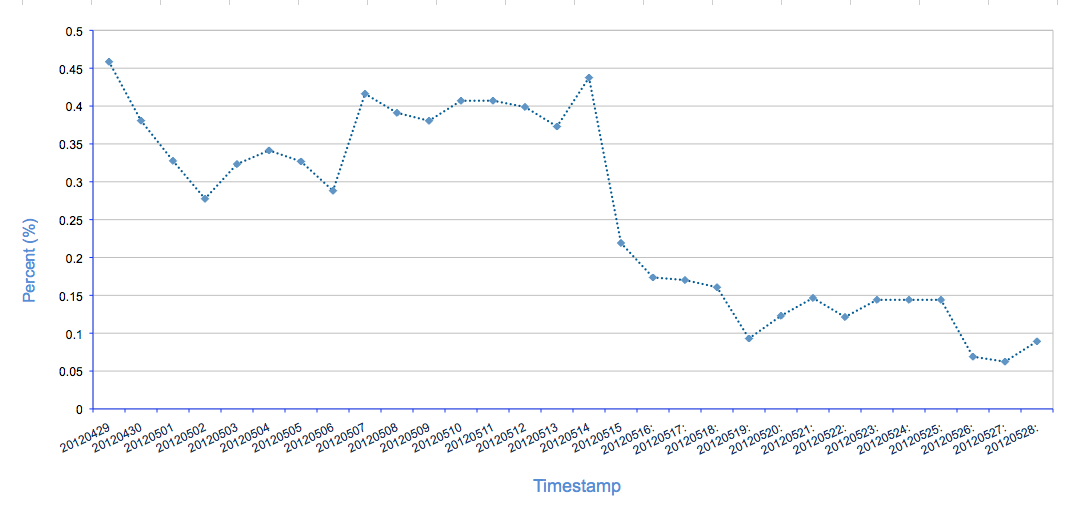
- IPv6 Penetration: It
is estimated using the formula IPv6_Penetration
(%) = 100 * Nv6 / Ns, where Ns
number of successful IPv4-only hits
and Nv6 the number of successful
IPv6
hits in an one-day period.
The penetration is (under/over) estimated to 0,11%.
The first graph shows the weekly average while the second graph depicts
the raw data per day. The first graph indicates a small increase of the
IPv6 penetration in the country. The second graphs shows sharp decrease
of IPv6 hits during the weekend possibly because there are no IPv6 hits
initiated from the university (dualstack) networks.
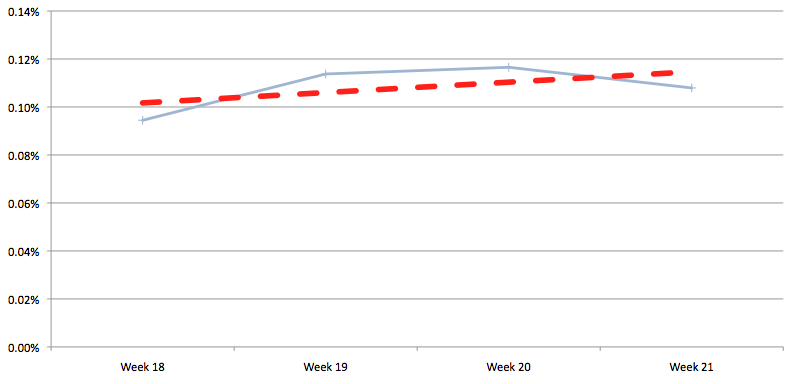
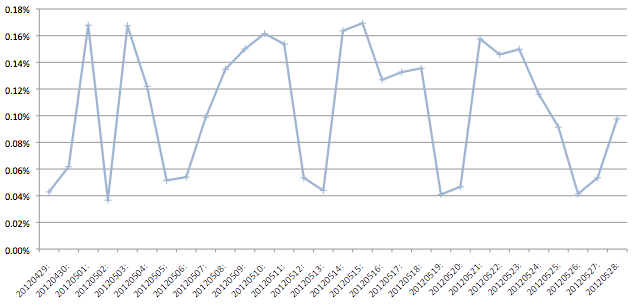
- Absolute number of IPv6 hits: It
shows
the Nv6, the number of successful
IPv6
hits in an one-day period.
As shown in the graph, the vast majority of users is connected using
native IPv6. The sharp increase -at the last week of May- is due to the
collection of more data from the second content provider.

- Distribution of IPv6 Brokenness in various
ISPs: The graphs shows
how IPv6 brokenness is distributed among the various Greek ISPs in
28th May 2012.
Large percentage of brokenness is expected to be related with ISPs with
high IPv6 penetration in their subscribers. In addition, some ISPs
without IPv6-enabled serviced are shown in the below graph because
their subscribers (unsuccessfully) enable IPv6 tunneling mechanisms.
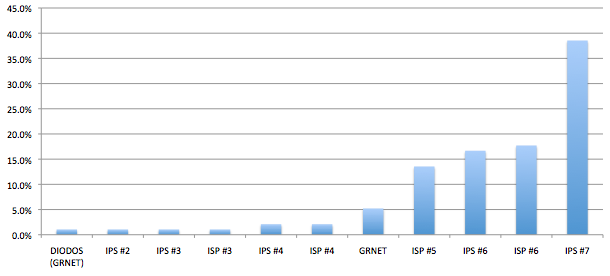
- Absolute number of IPv6 broken hits in
various ISPs: The
graph shows the absolute number of unsuccessful hits over IPv6 as distributed
among the various Greek ISPs in 28th May 2012. Large percentage of
brokenness is
expected to be related with ISPs with high IPv6 penetration in their
subscribers.
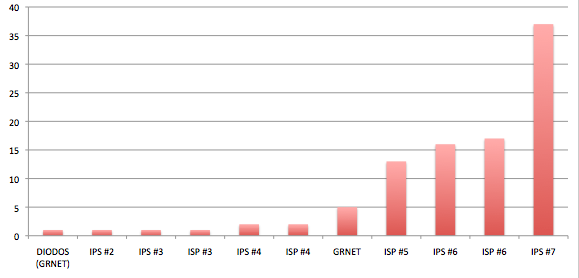
5. Credits
G.
Kargiotakis (GRNET), F.Liabotis (ex-GRNET), A.Liakopoulos (GRNET),
Y.Nikolopoulos (OTE), G.Potamianos(Skroutz.gr), K.Zorbadelos (OTE),
C.Gilitsas (SKAI.GR).
6. References
[1]
Open
Invitation to ISPs/Content Providers in Greece
[2]
IPv6 dual-stack client loss in Norway
[3]
Google IPv6
Statistics




